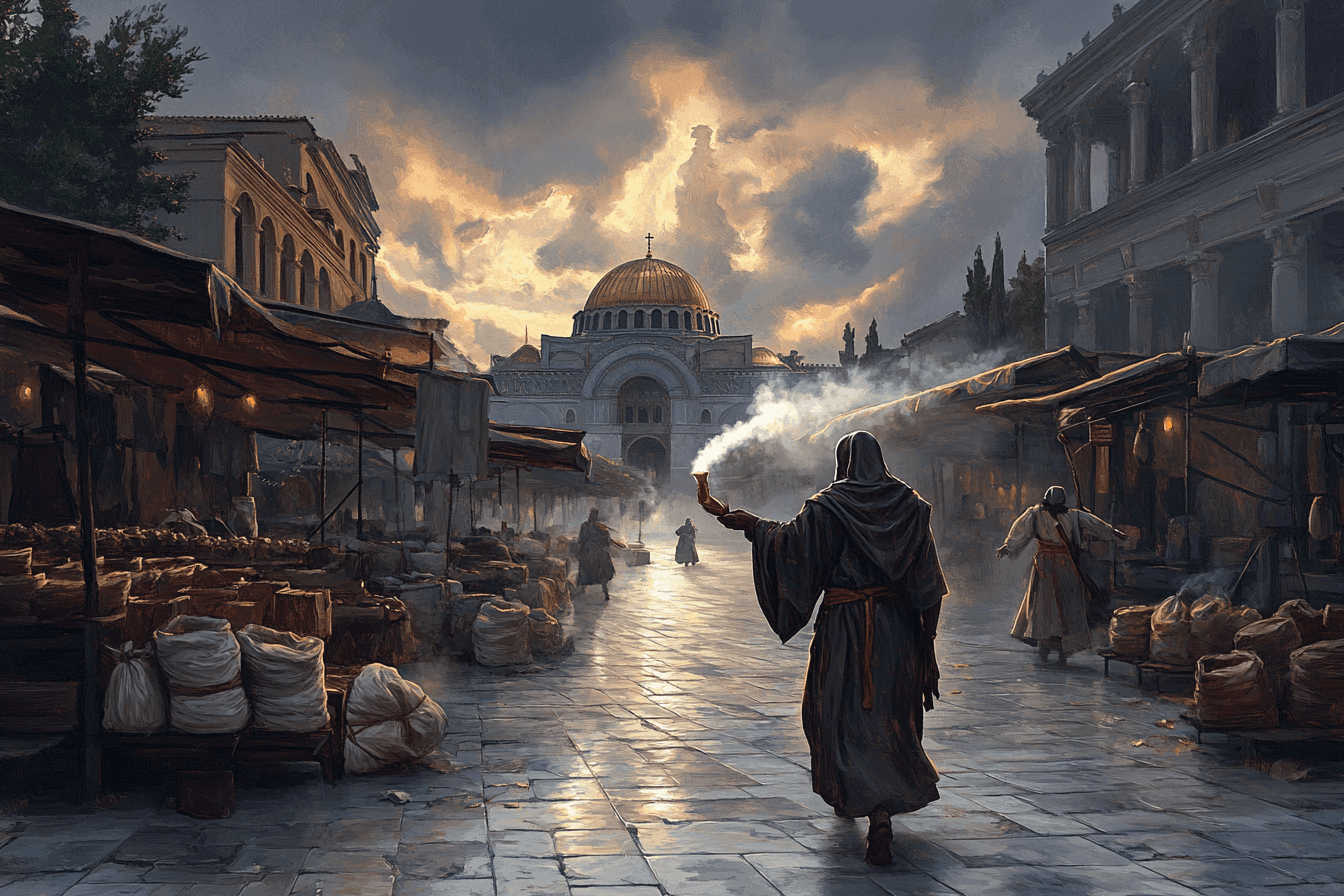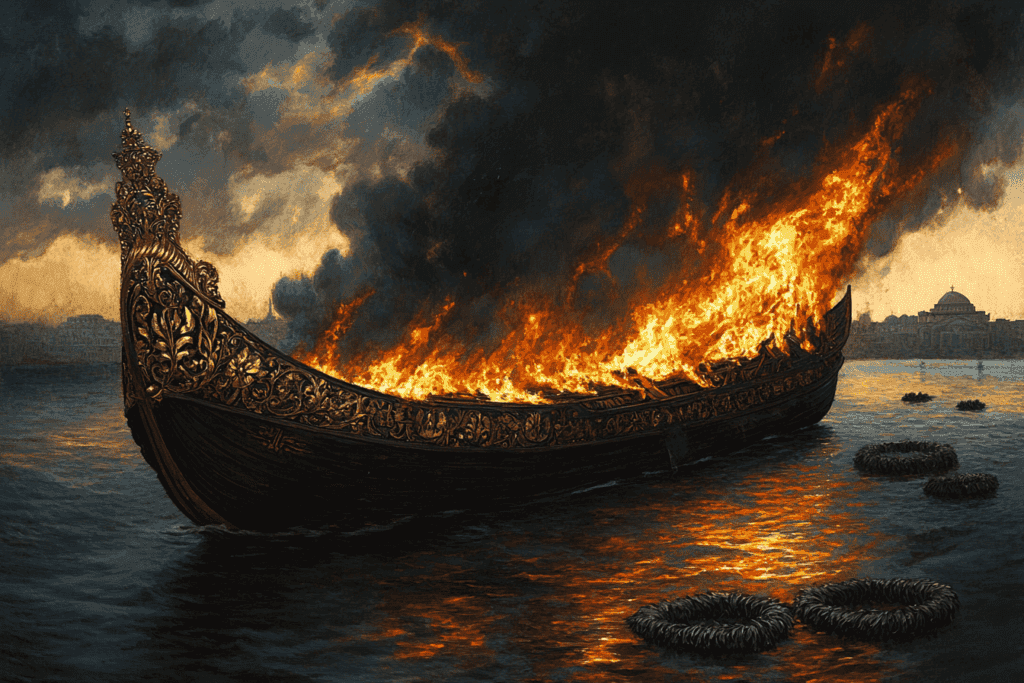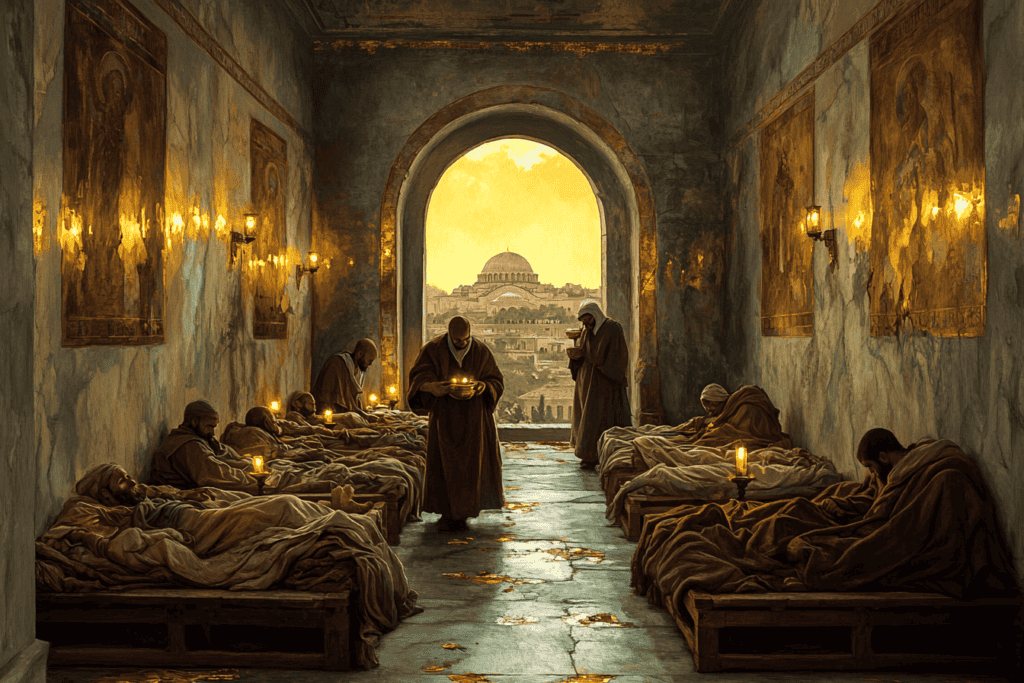
In the mid-6th century, a devastating pandemic swept across Europe and the Mediterranean, leaving death and destruction in its wake. Known as the Plague of Justinian, this catastrophic event would have far-reaching consequences for the Byzantine Empire and the wider world, marking a pivotal moment in the transition from antiquity to the Middle Ages.
Origins and Spread
The Plague of Justinian, named after the Byzantine Emperor Justinian I who ruled from 527 to 565 CE, first emerged in 541 CE. The disease is believed to have originated in Egypt, with the port city of Pelusium serving as the initial point of outbreak. From there, it rapidly spread throughout the Mediterranean basin, carried by ships transporting grain to the heart of the Byzantine Empire.
By the spring of 542 CE, the plague had reached Constantinople, the capital of the Byzantine Empire. The arrival of the disease in this bustling metropolis would prove to be a turning point, as it quickly overwhelmed the city’s population and infrastructure. Even Emperor Justinian himself fell ill, though he ultimately recovered.
As trade routes and military campaigns facilitated its spread, the plague soon engulfed the entire Mediterranean region, Europe, and parts of Asia and Africa. The pandemic would continue to resurface in waves for over two centuries, with its last recorded outbreak occurring around 750 CE.
The Nature of the Disease
Modern research has confirmed that the Plague of Justinian was caused by the bacterium Yersinia pestis, the same pathogen responsible for the infamous Black Death of the 14th century. This revelation has allowed historians and scientists to better understand the nature and impact of the disease.
The primary form of the plague during this pandemic was bubonic plague, characterized by painful swellings called buboes in the lymph nodes, particularly in the groin, armpits, and behind the ears. Victims also suffered from high fevers, chills, and severe disorientation.
Contemporary accounts provide vivid descriptions of the disease’s progression. Procopius, a historian in Justinian’s court, recounted that some victims lapsed into comas, while others became highly delusional. The speed at which the disease claimed lives was particularly terrifying, with some succumbing almost immediately after the onset of symptoms, while others suffered for days before death.
The Human Toll
The impact of the Plague of Justinian on human life was staggering. At the height of the pandemic in Constantinople, it is estimated that up to 10,000 people were dying each day. The sheer number of deaths overwhelmed the city’s capacity to properly handle the bodies of the deceased.
Emperor Justinian was forced to take unprecedented action, ordering the digging of massive pits to dispose of the rotting corpses. When these pits overflowed, bodies were stuffed into the towers of the city walls with quicklime poured over them to hasten decomposition. In a particularly grim measure, some corpses were loaded onto ships, pushed out into the Sea of Marmara, and set ablaze.

The plague’s reach extended far beyond Constantinople. It is estimated that between 25 million and 100 million people may have perished during the course of the pandemic. While the exact mortality rate is difficult to determine, some estimates suggest that up to 40% of the population in affected areas may have succumbed to the disease.
Economic and Social Disruption
The Plague of Justinian had profound economic and social consequences for the Byzantine Empire and the wider Mediterranean world. As the disease spread, it disrupted agriculture and trade, leading to food shortages and economic instability.
In Constantinople, the plague brought daily life to a standstill. Food supplies dwindled, and law and order broke down as the city grappled with the overwhelming number of deaths. The economic impact was felt throughout the empire, as tax revenues plummeted due to the massive loss of life and the disruption of agricultural production and trade.
The pandemic struck at a particularly inopportune time for Emperor Justinian. He had recently expended vast sums on military campaigns against the Vandals in North Africa and the Ostrogoths in Italy, as well as on ambitious construction projects like the Hagia Sophia. The plague’s devastating effect on the empire’s tax base severely hampered Justinian’s ability to fund these ongoing initiatives.

Political and Military Consequences
The Plague of Justinian had significant implications for the political and military landscape of the 6th century. The Byzantine Empire, already stretched thin by Justinian’s expansionist policies, found itself weakened at a critical juncture.
Prior to the outbreak, Justinian’s armies had made substantial progress in reconquering former Roman territories in Italy and North Africa. The plague, however, decimated his forces and depleted the empire’s resources, making it difficult to maintain control over these newly acquired lands.
This weakening of Byzantine power had far-reaching consequences. In Italy, for example, the Lombards were able to invade and establish their own kingdom in 568 CE, effectively ending Byzantine control over much of the peninsula. The plague also indirectly contributed to the rise of the Arab powers in the following century, as the weakened Byzantine and Sasanian empires were less able to resist the Arab expansion.
The long-term effects of the Plague of Justinian on European and Christian history were profound. The plague’s impact on population levels, economic structures, and political power dynamics contributed to the reshaping of European society in the centuries that followed.
Environmental Factors and Climate Change
Recent research has shed light on the potential role of climate change in the emergence and spread of the Plague of Justinian. A study examining lake sediments from central Turkey revealed that the onset of the plague coincided with a significant shift from a drier to a wetter climate in the eastern Mediterranean region.
This climatic change, which occurred around 536 CE, is believed to have created conditions favorable for the proliferation of rats and other rodents that carry the fleas responsible for transmitting the plague bacterium. The wetter climate likely increased food availability for these animals, leading to population booms that facilitated the rapid spread of the disease.
Interestingly, the study also found that the Justinian plague era came to an end around 750 CE, coinciding with a return to drier conditions. This correlation between climate patterns and the plague’s activity suggests that environmental factors played a crucial role in the pandemic’s dynamics.
The research highlights the complex interplay between climate, ecology, and human health, offering valuable insights for understanding both historical and contemporary disease outbreaks. It also serves as a stark reminder of the potential consequences of climate change on global health and the emergence of new pandemics.
Legacy and Lessons for Today
The Plague of Justinian, despite occurring nearly 1,500 years ago, offers valuable lessons for our modern world. As we grapple with global pandemics like COVID-19, the experiences of 6th-century societies in dealing with a widespread, deadly disease resonate with contemporary challenges.
One striking parallel is the role of government intervention in managing the crisis. Emperor Justinian’s unprecedented actions in organizing the disposal of bodies and attempting to maintain order in Constantinople foreshadow the critical role of state authorities in responding to public health emergencies.
The plague’s impact on trade and economy also mirrors modern concerns about the economic consequences of pandemics. The disruption of agricultural production, trade networks, and tax revenues during the Justinian plague offers historical perspective on the far-reaching economic effects of disease outbreaks.

Conclusion
The Plague of Justinian stands as a watershed moment in world history, a pandemic that reshaped the political, economic, and social landscape of the Mediterranean world and beyond. From 541 to 549 CE, and in recurring waves for two centuries thereafter, this devastating outbreak of bubonic plague claimed millions of lives and contributed to the transformation of the ancient world.
The Plague of Justinian left an indelible mark on human history. It challenged the might of the Byzantine Empire, altered the course of European development, and demonstrated the profound vulnerability of human societies to infectious diseases.
As we continue to face global health challenges in the 21st century, the story of the Plague of Justinian serves as a powerful reminder of the enduring impact of pandemics on human civilization. It underscores the importance of preparedness, the need for robust public health systems, and the complex interplay between disease, climate, and society.




